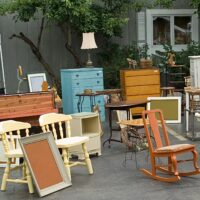How Do the Children Divide Up Mom’s Tangible Property?

What should you do if you’ve been given the task to be in charge of divvying up a parent’s estate that includes assorted tangible items?
Minneapolis Tribune’s article entitled “A clever way to divvy up items after a parent’s death” says that some families do it, by taking turns selecting which items each will keep.
The article discusses how a family decided to divide things up their mom’s grand estate and how the method the family used to divvy up the tangible items could be one that other families with much smaller estates could use.
After their mom’s death at 93, the brother and sister co-executors created an inventory of 724 items in her estate that had monetary or sentimental value. These included things like furniture, artwork, oriental rugs, cutlery, china, a piano and a car. They didn’t include their mom’s jewelry, books or linens, or her silver, gold and collectible coins. The four siblings all agreed to sell the coins and to deal with the many books, linens, and jewelry more informally, after the more significant items had been distributed.
The family didn’t use the common way of disbursing tangible items of an estate, in which family members take turns choosing items. With over 700 items, that could take a while. They felt that system wouldn’t maximize the value received by the four children and seven grandchildren. Instead, their process for dividing the intangible items used the following steps:
-
The inventory was given to all four siblings and asked each one to state the items that they were interested in. This divided the 724 items into three groups: (a) stuff in which no one had an interest; (b) stuff in which only one person had an interest; and (c) those in which two or more were interested. Things in which no one had an interest, were set aside to be sold or given away, and those who were the only siblings to want certain items got them.
-
They then made lists of items in which more than one sibling expressed an interest. Each received a list of those items. They were not given information on ones in which they weren’t interested—one of two ways the system wasn’t transparent.
-
Each person was then “given” 500 virtual poker chips that he or she could use to bid for contested items. However, prior to the bidding deadline, they could talk with one another about their intentions. The result was that many had bid for several similar items, like family pictures, bookcases and oriental rugs — when they really only wanted one from each category. Thus, they agreed among themselves who would receive each one, without wasting too many chips. This also avoided two siblings using a lot of tokens to bid for a particular item, and no one bidding on another similar one.
-
After the bids were in, the co-executors announced the results, without revealing the bids, to avoid a silent auction where bidders can see what others are bidding and readjust their bids up to the deadline. This was the second part of the system that wasn’t transparent.
-
Finally, when all the allocations were determined, the co-executors tabulated the monetary value of all the items and readjusted the estate monetary distributions to ensure that everyone came out at the same place financially. The most valuable items were a 1919 Steinway drawing room grand piano valued at $25, 000; a 2005 Toyota Camry valued at $4, 500; and some oriental rugs with a total value of $13, 975. Those who got the big-ticket items had to pay their siblings something for them, with a total of $17, 500 trading hands.
It was time-consuming and took several months, but the siblings thought that their system was very fair and the process, unlike what is done in some other family estates, relieved tensions and brought the siblings closer together.
Reference: Minneapolis Tribune (Feb. 25, 2020) “A clever way to divvy up items after a parent’s death”
